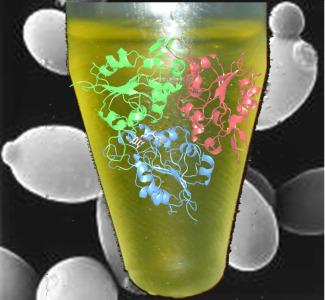New discoveries in the yeast Saccharomyces cerevisiae

The study, entitled "Moonlighting Proteins HAL3 and VHS3 Form a Heteromeric PPCDC with YKL088w in Yeast CoA Biosynthesis" and published in Nature Chemical Biology, was carried out by researchers of the UAB Department of Biochemistry and Molecular Biology and the University of Stellenbosch, South Africa, under the coordination of Dr Joaquin Ariño.
PPCDC is an essential enzyme and plays a key role in the synthesis of Coenzyme A, a molecule universally conserved in eukaryotic cells which intervenes in the degradation of fatty acids, carbohydrates and amino acids in all organisms (bacteria, plants and humans). The gene involved in the formation of PPCDC was identified in plants and humans. In both cases, the enzyme is a homotrimeric complex, i.e. it is formed by the association of three identical proteins. The interaction of the three is precisely what determines the formation of the three identical active sites- areas of the enzyme in which the catalytic process takes place - it contains. However, its nature in the yeast Saccharomyces cerevisiae was a mystery to researchers, given that this organism seems to contain three genes potentially capable of coding a PPCDC (HAL3, VHS3 and YKL088w), but none of them could be associated with this function.
The research carried out by the UAB group has helped to clarify this apparent paradox by demonstrating that the S. cerevisiae enzyme exists as a heterotrimer, i.e. it is formed by 3 non-identical proteins. One of these proteins is necessarily coded by the YKL088w gene (which explains its essential nature) and the other can be two molecules coded by either HAL3 or VHS3, or even one of each. The active site in this case is made up of amino acids of two different proteins: the one coded by gene YKL088w, which provides a catalytic cysteine, and the one coded by HAL3 or VHS3, which provides a histidine, also essential for the catalysis.
This discovery is even more surprising if one takes into account that in recent years the UAB group has discovered that the genes HAL3 and VHS3 function in a completely different manner in Saccharomyces cerevisiae by regulating the activity of a protein phosphatase involved in the saline tolerance and in the cell cycle. Therefore, the proteins coded by HAL3 and VHS3 are examples of "moonlighting" proteins, that is, they are capable of carrying out completely different functions (at least apparently) in the cell.
The research carried out by Dr Ariño's group in collaboration with the University of Stellenbosch demonstrates that the heterotrimeric structure of the PPCDC can exist in a wide group of yeasts from the Ascomycetes division. This group not only includes yeasts which can be used in biotechnology and industries, such as S. cerevisiae and Pichia pastoris, but also potential pathogens such as Candida albicans. The difference between the PPCDC structure in these organisms and that of the human enzyme, together with its characteristic as an essential enzyme, makes it a possible target for antifungal therapy.
References
"Moonlighting Proteins Hal3 and Vhs3 Form a Heteromeric PPCDC with Ykl088w in Yeast CoA Biosynthesis". Amparo Ruíz, Asier González, Iván Muñoz, Raquel Serrano, J. Albert Abrie, Erick Strauss & Joaquín Ariño. Nature Chemical Biology. In press (2009).

